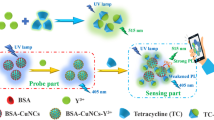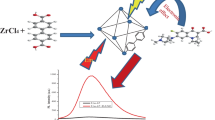Abstract
A novel fluorescence “off–on” probe was developed using a boron difluoride–modified zinc metal–organic framework (Zn-MOF3) for sensitive determination of tetracycline (TC) and Al3+. The Zn-MOF3 has excellent optical property and good applicability in aqueous phase. The fluorescence recorded at 436 nm was quenched at the excitation wavelength of 336 nm. Signal-off detection of tetracycline via fluorescence quenching of Zn-MOF3 is based on the inner filter effect. Fluorescence on–off-on detection of Al3+ occurs via the specific binding between tetracycline and Al3+. The limits of detection for TC and Al3+ were 28.4 nM and 106.7 nM, respectively. This probe exhibited high selectivity which was used for the determination of TC and Al3+ with satisfied recoveries (89.8 to 105.6% for TC, 90.0 to 110.4% for Al3+) and good precision (< 5%) in milk. The developed sensor represents the first “off–on” system for fluorescence detection of TC and Al3+ based on Zn-MOF3 with a better aspect of the innovation.
Graphical Abstract








Similar content being viewed by others
References
Jin Y, Zhang J, Zhao W, Zhang W, Wang L, Zhou J, Li Y (2017) Development and validation of a multiclass method for the quantification of veterinary drug residues in honey and royal jelly by liquid chromatography–tandem mass spectrometry. Food Chem 221:1298–1307
Granados JAO, Thangarasu P, Singh N, Vázquez-Ramos JM (2019) Tetracycline and its quantum dots for recognition of Al3+ and application in milk developing cells bio-imaging. Food Chem 278:523–532
Granados-Chinchilla F, Rodríguez C (2017) Tetracyclines in food and feedingstuffs: from regulation to analytical methods, bacterial resistance, and environmental and health implications. J Anal Methods Chem 2017:1315497
Xie J, Li C, Li Y, Fu Y, Nie S, Tan H (2017) A near-infrared chemosensor for determination of trivalent aluminum ions in living cells and tissues. Dyes Pigm 136:817–824
Xie X, Qin Y (2011) A dual functional near infrared fluorescent probe based on the bodipy fluorophores for selective detection of copper and aluminum ions. Sensors Actuators B: Chem 156(1):213–217
Ahmadi F, Shahbazi Y, Karami N (2015) Determination of tetracyclines in meat using two phases freezing extraction method and HPLC-DAD. Food Anal Methods 8(7):1883–1891
Miranda JM, Rodríguez JA, Galán-Vidal CA (2009) Simultaneous determination of tetracyclines in poultry muscle by capillary zone electrophoresis. J Chromatogr A 1216(15):3366–3371
Devkota L, Nguyen LT, Vu TT, Piro B (2018) Electrochemical determination of tetracycline using AuNP-coated molecularly imprinted overoxidized polypyrrole sensing interface. Electrochim Acta 270:535–542
Wang G, Zhang H, Liu J, Wang J (2019) A receptor-based chemiluminescence enzyme linked immunosorbent assay for determination of tetracyclines in milk. Anal Biochem 564–565:40–46
Wu Q, Peng D, Liu Q, Shabbir MAB, Sajid A, Liu Z, Wang Y, Yuan Z (2019) A novel microbiological method in microtiter plates for screening seven kinds of widely used antibiotics residues in milk, chicken egg and honey. Front Microbiol 10:436
Kanu AB (2021) Recent developments in sample preparation techniques combined with high-performance liquid chromatography: a critical review. J Chromatogr A 1654:462444
Khanhuathon Y, Siriangkhawut W, Chantiratikul P, Grudpan K (2015) Spectrophotometric method for determination of aluminium content in water and beverage samples employing flow-batch sequential injection system. J Food Compost Anal 41:45–53
Nguyen KL, Lewis DM, Jolly M, Robinson J (2004) Determination of soluble aluminium concentration in alkaline humic water using atomic absorption spectrophotometry. Water Res 38(19):4039–4044
Frankowski M, Zioła-Frankowska A, Kurzyca I, Novotný K, Vaculovič T, Kanický V, Siepak M, Siepak J (2011) Determination of aluminium in groundwater samples by GF-AAS, ICP-AES, ICP-MS and modelling of inorganic aluminium complexes. Environ Monit Assess 182(1):71–84
Hong YS, Choi JY, Nho EY, Hwang IM, Khan N, Jamila N, Kim KS (2019) Determination of macro, micro and trace elements in citrus fruits by inductively coupled plasma–optical emission spectrometry (ICP-OES), ICP–mass spectrometry and direct mercury analyzer. J Sci Food Agric 99(4):1870–1879
Zhang Z, Wu M, Phan A, Alanazi M, Yong J, Ping XuZ, Sultanbawa Y, Zhang R (2023) Development of europium(III) complex functionalized silica nanoprobe for luminescence detection of tetracycline. Methods 214:1–7
Zhang Z, Zhang H, Tian D, Phan A, Seididamyeh M, Alanazi M, Ping XuZ, Sultanbawa Y, Zhang R (2024) Luminescent sensors for residual antibiotics detection in food: recent advances and perspectives. Coord Chem Rev 498:215455
Ali M, Shah I, Kim SW, Sajid M, Lim JH, Choi KH (2018) Quantitative detection of uric acid through ZnO quantum dots based highly sensitive electrochemical biosensor. Sens Actuator A: Phys 283:282–290
Ensafi AA, Nasr-Esfahani P, Rezaei B (2018) Synthesis of molecularly imprinted polymer on carbon quantum dots as an optical sensor for selective fluorescent determination of promethazine hydrochloride. Sensors Actuators B: Chem 257:889–896
Yuvasri GS, Goswami N, Xie J (2019) AIE-type metal nanoclusters: synthesis, luminescence, fundamentals and applications. In: Tang Y, Tang BZ (eds) Principles and applications of aggregation-induced emission. Springer International Publishing, Cham, pp 265–289
Wang Y, Liu X, Wang M, Wang X, Ma W, Li J (2021) Facile synthesis of CDs@ZIF-8 nanocomposites as excellent peroxidase mimics for colorimetric detection of H2O2 and glutathione. Sensors Actuators B: Chem 329:129115
Zhou H-CJ, Kitagawa S (2014) Metal–organic frameworks (MOFs). Chem Soc Rev 43(16):5415–5418
Stock N, Biswas S (2012) Synthesis of metal-organic frameworks (MOFs): routes to various mof topologies, morphologies, and composites. Chem Rev 112(2):933–969
Jiao L, Seow JYR, Skinner WS, Wang ZU, Jiang H-L (2019) Metal–organic frameworks: structures and functional applications. Mater Today 27:43–68
Ashworth C (2017) Metal–organic frameworks: molten MOFs. Nat Rev Mater 2(11):17074
Pang Y, Cao Y, Han J, Xia Y, He Z, Sun L, Liang J (2022) A novel fluorescence sensor based on Zn porphyrin MOFs for the detection of bisphenol A with highly selectivity and sensitivity. Food Control 132:108551
Zheng X, Zhao Y, Jia P, Wang Q, Liu Y, Bu T, Zhang M, Bai F, Wang L (2020) Dual-emission Zr-MOF-based composite material as a fluorescence turn-on sensor for the ultrasensitive detection of Al3+. Inorg Chem 59(24):18205–18213
Pan Y, Wang J, Guo X, Liu X, Tang X, Zhang H (2018) A new three-dimensional zinc-based metal-organic framework as a fluorescent sensor for detection of cadmium ion and nitrobenzene. J Colloid Interface Sci 513:418–426
Kumar P, Deep A, Kim K-H (2015) Metal organic frameworks for sensing applications. TrAC, Trends Anal Chem 73:39–53
Xu L, Fang G, Liu J, Pan M, Wang R, Wang S (2016) One-pot synthesis of nanoscale carbon dots-embedded metal–organic frameworks at room temperature for enhanced chemical sensing. J Mater Chem A 4(41):15880–15887
Kumar A, Chowdhuri AR, Kumari A, Sahu SK (2018) IRMOF-3: a fluorescent nanoscale metal organic frameworks for selective sensing of glucose and Fe (III) ions without any modification. Mater Sci Eng C 92:913–921
Xu J, Shen X, Jia L, Zhou T, Ma T, Xu Z, Cao J, Ge Z, Bi N, Zhu T, Guo S, Li X (2018) A novel visual ratiometric fluorescent sensing platform for highly-sensitive visual detection of tetracyclines by a lanthanide-functionalized palygorskite nanomaterial. J Hazard Mater 342:158–165
Chowdhuri AR, Singh T, Ghosh SK, Sahu SK (2016) Carbon dots embedded magnetic nanoparticles @chitosan @metal organic framework as a nanoprobe for pH sensitive targeted anticancer drug delivery. ACS Appl Mater Interfaces 8(26):16573–16583
Wang Z, Cohen SM (2007) Postsynthetic covalent modification of a neutral metal−organic framework. J Am Chem Soc 129(41):12368–12369
Rostamnia S, Morsali A (2014) Size-controlled crystalline basic nanoporous coordination polymers of Zn4O(H2N-TA)3: catalytically study of IRMOF-3 as a suitable and green catalyst for selective synthesis of tetrahydro-chromenes. Inorg Chim Acta 411:113–118
Wei J, Wang X, Sun X, Hou Y, Zhang X, Yang D, Dong H, Zhang F (2018) Rapid and large-scale synthesis of IRMOF-3 by electrochemistry method with enhanced fluorescence detection performance for TNP. Inorg Chem 57(7):3818–3824
Wang Q, Qi X, Chen H, Li J, Yang M, Liu J, Sun K, Li Z, Deng G (2022) Fluorescence determination of chloramphenicol in milk powder using carbon dot decorated silver metal–organic frameworks. Microchim Acta 189(8):272
Zhao M, Deng K, He L, Liu Y, Li G, Zhao H, Tang Z (2014) Core–shell palladium nanoparticle@metal–organic frameworks as multifunctional catalysts for cascade reactions. J Am Chem Soc 136(5):1738–1741
Liu S-Q, Zhu X-L, Zhou Y, Meng Z-D, Chen Z-G, Liu C-B, Chen F, Wu Z-Y, Qian J-C (2017) Smart photocatalytic removal of ammonia through molecular recognition of zinc ferrite/reduced graphene oxide hybrid catalyst under visible-light irradiation. Catal Sci Technol 7(15):3210–3219
Liu B, Fischer RA (2011) Liquid-phase epitaxy of metal organic framework thin films. Sci China Chem 54(12):1851–1866
Yoo Y, Jeong H-K (2012) Generation of covalently functionalized hierarchical IRMOF-3 by post-synthetic modification. Chem Eng J 181–182:740–745
Li C, Zhu L, Yang W, He X, Zhao S, Zhang X, Tang W, Wang J, Yue T, Li Z (2019) Amino-functionalized Al–MOF for fluorescent detection of tetracyclines in milk. J Agric Food Chem 67(4):1277–1283
Lin M, Zou HY, Yang T, Liu ZX, Liu H, Huang CZ (2016) An inner filter effect based sensor of tetracycline hydrochloride as developed by loading photoluminescent carbon nanodots in the electrospun nanofibers. Nanoscale 8(5):2999–3007
Zhou Y, Yang Q, Zhang D, Gan N, Li Q, Cuan J (2018) Detection and removal of antibiotic tetracycline in water with a highly stable luminescent MOF. Sensors Actuators B: Chem 262:137–143
Li X, Ma H, Deng M, Iqbal A, Liu X, Li B, Liu W, Li J, Qin W (2017) Europium functionalized ratiometric fluorescent transducer silicon nanoparticles based on FRET for the highly sensitive detection of tetracycline. J Mater Chem C 5(8):2149–2152
Chandra S, Bano D, Pradhan P, Singh VK, Yadav PK, Sinha D, Hasan SH (2020) Nitrogen/sulfur-co-doped carbon quantum dots: a biocompatible material for the selective detection of picric acid in aqueous solution and living cells. Anal Bioanal Chem 412(15):3753–3763
Zhou C, He X, Ya D, Zhong J, Deng B (2017) One step hydrothermal synthesis of nitrogen-doped graphitic quantum dots as a fluorescent sensing strategy for highly sensitive detection of metacycline in mice plasma. Sensors Actuators B: Chem 249:256–264
Chen D, Tian J, Chen M, Liu C, Du M (2016) Moisture-stable Zn(II) metal–organic framework as a multifunctional platform for highly efficient CO2 capture and nitro pollutant vapor detection. ACS Appl Mater Interfaces 8(28):18043–18050
Funding
This study was financially supported by the Opening Project of Medical Imaging Key Laboratory of Sichuan Province (No. MIKL202203), the Sichuan Provincial Students’ Innovation and Entrepreneurship Training Program (No. S202314389202), and the Scientific Research Innovation Team Funds of Chengdu Normal University (No. CSCXTD2020A05).
Author information
Authors and Affiliations
Contributions
Qihui Wang: data curation, methodology, investigation, and writing—original draft; Haochen Du, Rui Tang, Xiaohui Wang, and Lei Xie: data curation; Jun Liu: writing—review; Kang Sun: investigation and writing—review and editing; Zhonghui Li: funding acquisition and project administration; Guowei Deng: writing—review and editing, funding acquisition, and project administration.
Corresponding authors
Ethics declarations
Conflict of interest
The authors declare no competing interests.
Additional information
Publisher's Note
Springer Nature remains neutral with regard to jurisdictional claims in published maps and institutional affiliations.
Supplementary Information
Below is the link to the electronic supplementary material.
Rights and permissions
Springer Nature or its licensor (e.g. a society or other partner) holds exclusive rights to this article under a publishing agreement with the author(s) or other rightsholder(s); author self-archiving of the accepted manuscript version of this article is solely governed by the terms of such publishing agreement and applicable law.
About this article
Cite this article
Wang, Q., Du, H., Tang, R. et al. Boron difluoride modified zinc metal–organic framework-based “off–on” fluorescence sensor for tetracycline and Al3+ detection. Microchim Acta 191, 144 (2024). https://doi.org/10.1007/s00604-024-06211-9
Received:
Accepted:
Published:
DOI: https://doi.org/10.1007/s00604-024-06211-9




